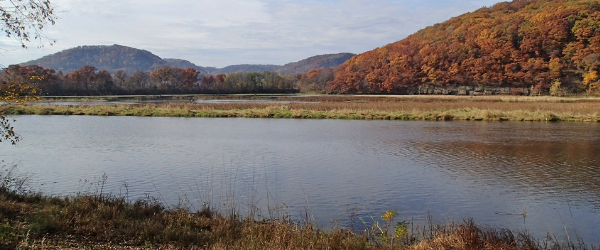A buried waterfall on a backwards Mississippi River

Today the Mississippi River flows gently from its headwaters in Minnesota toward the Gulf of Mexico, but this was not always the case. New research, published in Science Advances, documents how continental glaciers and movements of the Earth's surface worked in tandem to reshape the upper Midwest and create the modern Mississippi River and its valley.
Rivers carve their own channels and valley floors into the solid rock that underlies landscapes, while also transporting loose sediment such as sand and gravel downstream. In the upper Mississippi, however, much of the bedrock is ‘missing.’ This puzzle motivated Andrew Wickert, Assistant Professor in the Department of Earth Sciences and faculty at the St. Anthony Falls Laboratory at the University of Minnesota, to undertake a meticulous mapping project of the upper Mississippi River valley over the past decade.
Utilizing geotechnical borings, seismic surveys, and well log data, Wickert discovered that the shape of bedrock profile wasn’t exactly what researchers would expect. A 180-foot waterfall lies buried beneath sand and gravel at Dubuque, Iowa. Downstream of that buried waterfall, the bedrock actually slopes backwards, meaning the river would drain to the north instead of to the south as it does today.
What could have caused the bedrock to sink so far into the Earth and how could part of it slope backwards? Wickert quickly realized that such an unusual bedrock profile most likely could have formed at only one time: when continental glaciers first advanced across the upper Midwest, sometime between 790,000 and 2,500,000 years ago, rerouting rivers that formerly flowed north and sending their waters south into the evolving Mississippi River (see animation at right). In addition to redirecting rivers, these kilometer-thick ice sheets depressed the Earth’s surface beneath them, but caused it to rise around their margins (similar to pushing your fist into a ball of dough). When the glacier then melts and retreats, that uplifted land then sinks.
Working with Jerry Mitrovica of Harvard University, who models how the Earth deforms under the weight of glaciers, and Bob Anderson, an expert in rivers and glaciers at the University of Colorado Boulder, Wickert modeled the evolving Mississippi River valley. When continental glaciers advanced, rerouting tributary rivers and sending torrents of water into the Mississippi while also uplifting the land, the Mississippi River deeply incised into the underlying rock. When the glaciers retreated and the land subsided, this new deep valley tilted and sank, forming a hole in the landscape that was filled by sediment, burying the deformed and upstream-sloping bedrock profile.
The 180-ft waterfall at Dubuque was also buried when the land subsided, leaving it “frozen in time” as it eroded upstream. It stands at the boundary between different types of bedrock: softer sandstone and shale (downstream) and more erosion-resistant limestone (upstream). Most likely, the river rapidly eroded through the softer sandstone until it reached the limestone, where erosion slowed and it formed a steep reach of waterfalls and rapids.
“If you can picture the upper Mississippi River, more than likely you'll think about its size, its wetlands, bluffs, its fish, or how we use it,” says Wickert, “You don't think of 180-foot waterfalls or the fact that it once was split into multiple rivers. This buried landscape points to a much more dramatic evolution than you would expect."
This work was supported by the National Science Foundation Graduate Research Fellowship Program under Grant No. DGE 1144083, the Department of Defense (DoD) through the National Defense Science & Engineering Graduate Fellowship (NDSEG) Program, and funds provided to Wickert and Mitrovica by the University of Minnesota and Harvard University. The work also benefited from the work and contributions of Eric Carson of the Wisconsin Geological and Natural History Survey and Shawn Naylor of the Indiana Geological & Water Survey.
